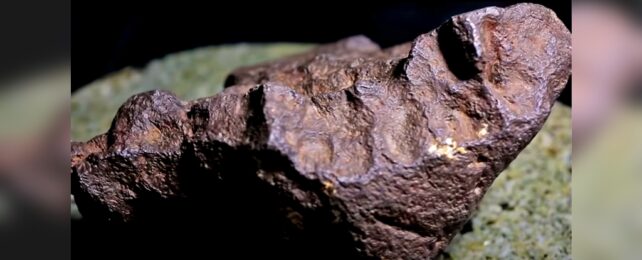One of the largest meteorites ever recorded in Michigan never came to the attention of experts until a whopping 80+ years after its discovery.
Living a humble life as a 10-kilogram (22-pound) doorstop at a local farm, the space rock laid around for several decades before being recognized by the scientific community.
"I could tell right away that this was something special," Mona Sirbescu, a geologist at Central Michigan University (CMU), explained in 2018 after investigating the object.
"It's the most valuable specimen I have ever held in my life, monetarily and scientifically."
David Mazurek, a man from Grand Rapids, Michigan, had asked Sirbescu if she could examine a rock he'd had for 30 years – in case it was a meteorite.
For Sirbescu, this had been a regular request throughout her career, yet usually with no exciting outcomes.
"For 18 years, the answer has been categorically 'no' … not meteorites," she explained in a statement at the time.
But on this occasion, the answer was different.
Not only was it indeed a space rock, but a spectacular one at that.
The object, nicknamed the Edmore meteorite, is a large iron-nickel meteorite with a considerable amount of nickel, constituting around 12 percent.
How the meteorite came into Mazurek's possession is a story in itself.
According to Sirbescu, when Mazurek bought a farm in Edmore, Michigan in 1988, he was shown around the property by the previous owner, and saw a large, strange-looking rock being used to prop open a shed door.
When Mazurek asked the outgoing owner about the rock, he was told the doorstop was actually a meteorite.
The man went on to say that in the 1930s he and his father had seen the meteorite shoot down at night onto their property, "and it made a heck of a noise when it hit".
The next morning, the pair found the crater left by the object, and dug the meteorite out of the newly formed ditch. It was still warm, they said.
The craziest bit? The man told Mazurek that, since the meteorite was a part of the property, it would now belong to him.
And so Mazurek kept the space rock for 30 years, and continued using it as a doorstop – except for the occasions when his kids took the rock to school for show and tell.
Eventually, he noticed people were making money from finding and selling small pieces of meteorites, so he figured he should get his giant rock evaluated.
We can imagine Mazurek must have been elated when he finally did so, as meteorites – due to their rarity and scientific value – can often fetch high price tags.
"What typically happens with these at this point is that meteorites can either be sold and shown in a museum or sold to collectors and sellers looking to make a profit," Sirbescu said.
In the end, Mazurek sold his meteorite to Michigan State University's Abrams Planetarium, pledging 10 percent of the windfall to CMU's earth and atmospheric sciences department, where Sirbescu identified the rock's true identity.
The price tag? $75,000.
Not too bad for an old doorstop.
An earlier version of this article was published in October 2018.
